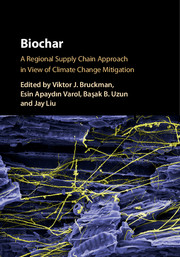Book contents
- BiocharA Regional Supply Chain Approach in View of Climate Change Mitigation
- Biochar
- Copyright page
- Dedication
- Contents
- Contributors
- Preface
- 1 Biochar in the View of Climate Change Mitigation: the FOREBIOM Experience
- Part I The Interdisciplinary Approach
- Part II Sustainable Biomass Resources
- Part III Biochar Production
- Part IV Biochar Application as a Soil Amendment
- 14 Biochar Applications to Agricultural Soils in Temperate Climates – More Than Carbon Sequestration?
- 15 Opportunities and Uses of Biochar on Forest Sites in North America
- 16 The Role of Mycorrhizae and Biochar in Plant Growth and Soil Quality
- 17 The Use of Stable Isotopes in Understanding the Impact of Biochar on the Nitrogen Cycle
- 18 Biochar Amendment Experiments in Thailand: Practical Examples
- Index
- Plate Section (PDF Only)
- References
14 - Biochar Applications to Agricultural Soils in Temperate Climates – More Than Carbon Sequestration?
from Part IV - Biochar Application as a Soil Amendment
Published online by Cambridge University Press: 01 December 2016
- BiocharA Regional Supply Chain Approach in View of Climate Change Mitigation
- Biochar
- Copyright page
- Dedication
- Contents
- Contributors
- Preface
- 1 Biochar in the View of Climate Change Mitigation: the FOREBIOM Experience
- Part I The Interdisciplinary Approach
- Part II Sustainable Biomass Resources
- Part III Biochar Production
- Part IV Biochar Application as a Soil Amendment
- 14 Biochar Applications to Agricultural Soils in Temperate Climates – More Than Carbon Sequestration?
- 15 Opportunities and Uses of Biochar on Forest Sites in North America
- 16 The Role of Mycorrhizae and Biochar in Plant Growth and Soil Quality
- 17 The Use of Stable Isotopes in Understanding the Impact of Biochar on the Nitrogen Cycle
- 18 Biochar Amendment Experiments in Thailand: Practical Examples
- Index
- Plate Section (PDF Only)
- References
Summary
Biochar as a boon for soil fertility in the tropics still has to show that it is able to provide the same benefits to soils in temperate regions. Here an Austrian study with the objective to analyze the extent of benefits that biochar application offers to agricultural soils in Europe beyond its role as a carbon sequestration strategy is presented. Based on hypothesis testing, several potential benefits of biochar were examined in a series of lab analyses, greenhouse and field experiments. Three hypotheses could be confirmed: biochar can protect groundwater by reducing the nitrate migration in seepage water; biochar can mitigate atmospheric greenhouse gas accumulation by reducing soil N2O emissions; and biochar can improve soil physical properties by increasing water storage capacity. One hypothesis was only partly confirmed: biochar supports the thriving of soil microorganisms only in specific soil and climate settings. Two hypotheses were refuted: biochar does not generally provide nutrients to plants except when produced from specific feedstocks or by combining it with mineral or organic fertilizers; the cost-effectiveness of biochar application is not given under current production costs if the existing benefits of biochar are not transferable to financial value.
- Type
- Chapter
- Information
- BiocharA Regional Supply Chain Approach in View of Climate Change Mitigation, pp. 291 - 314Publisher: Cambridge University PressPrint publication year: 2016
References
- 2
- Cited by

